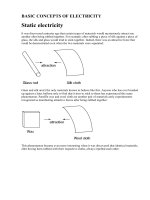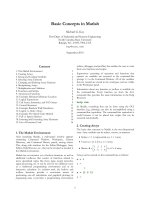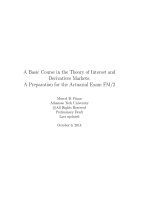Lecture Data security and encryption - Chapter 4: Basic concepts in number theory and finite fields
Bạn đang xem bản rút gọn của tài liệu. Xem và tải ngay bản đầy đủ của tài liệu tại đây (425.6 KB, 26 trang )
Data Security and Encryption
(CSE348)
1
Lecture # 4
2
Review
– classical cipher techniques and terminology
– Brute Force
• Cryptanalysis of Brute Force
– Caesar Cipher
• Cryptanalysis of Caesar Cipher
3
Monoalphabetic Cipher
• With only 25 possible keys, the Caesar cipher is
far from secure
• A dramatic increase in the key space can be
achieved
• By allowing an arbitrary substitution, where the
translation alphabet can be any permutation of
the 26 alphabetic characters
4
Monoalphabetic Cipher
• A permutation of a finite set of elements S
• An ordered sequence of all the elements of S,
with each element appearing exactly once.
• In general, there are n! permutations of a set of
n elements.
5
Monoalphabetic Cipher
• rather than just shifting the alphabet
• could shuffle (jumble) the letters arbitrarily
• each plaintext letter maps to a different random
ciphertext letter
• hence key is 26 letters long
Plain: abcdefghijklmnopqrstuvwxyz
Cipher: DKVQFIBJWPESCXHTMYAUOLRGZN
Plaintext: ifwewishtoreplaceletters
Ciphertext: WIRFRWAJUHYFTSDVFSFUUFYA
6
Monoalphabetic Cipher Security
•
•
•
•
now have a total of 26! = 4 x 10 26 keys
with so many keys, might think is secure
but would be !!!WRONG!!!
problem is language characteristics
7
Language Redundancy and
Cryptanalysis
• As the example shows, we don't actually need
all the letters in order to understand written
English text
• Here vowels were removed, but they're not the
only redundancy
• Has no vowels for same reason
• Are usually familiar with "party conversations",
can hear one person speaking out of hubbub of
many, again because of redundancy in aural
8
Language Redundancy and
Cryptanalysis
• This redundancy is also the reason we can
compress text files, the computer can derive a
more compact encoding without losing any
information
• Basic idea is to count the relative frequencies of
letters, and note the resulting pattern.
9
Language Redundancy and
Cryptanalysis
human languages are redundant
eg "th lrd s m shphrd shll nt wnt"
letters are not equally commonly used
in English E is by far the most common letter
followed by T,R,N,I,O,A,S
other letters like Z,J,K,Q,X are fairly rare
have tables of single, double & triple letter
frequencies for various languages
10
English Letter Frequencies
11
Use in Cryptanalysis
• key concept - monoalphabetic substitution
ciphers do not change relative letter frequencies
• discovered by Arabian scientists in 9th century
• calculate letter frequencies for ciphertext
• compare counts/plots against known values
• if caesar cipher look for common peaks/troughs
– peaks at: A-E-I triple, NO pair, RST triple
– troughs at: JK, X-Z
• for monoalphabetic must identify each letter
– stables of common double/triple letters help
12
Use in Cryptanalysis
• Monoalphabetic ciphers are easy to break
• because they reflect the frequency data of the
original alphabet.
13
Example Cryptanalysis
• given ciphertext:
UZQSOVUOHXMOPVGPOZPEVSGZWSZOPFPESXUDBMETSXAIZ
VUEPHZHMDZSHZOWSFPAPPDTSVPQUZWYMXUZUHSX
EPYEPOPDZSZUFPOMBZWPFUPZHMDJUDTMOHMQ
•
•
•
•
count relative letter frequencies (see text)
guess P & Z are e and t
guess ZW is th and hence ZWP is the
proceeding with trial and error finally get:
it was disclosed yesterday that several informal but
direct contacts have been made with political
representatives of the viet cong in moscow
14
Playfair Cipher
not even the large number of keys in a
monoalphabetic cipher provides security
one approach to improving security was to
encrypt multiple letters
the Playfair Cipher is an example
invented by Charles Wheatstone in 1854,
but named after his friend Baron Playfair
15
Playfair Key Matrix
a 5X5 matrix of letters based on a
keyword
fill in letters of keyword (sans duplicates)
fill rest of matrix with other letters
eg. using
the Okeyword
MONARCHY
M
N
A
R
C
H
Y
B
D
E
F
G
I/J
K
L
P
Q
S
T
U
V
W
X
Z
16
Encrypting and Decrypting
• plaintext is encrypted two letters at a time
1. if a pair is a repeated letter, insert filler like 'X’
2. if both letters fall in the same row, replace
each with letter to right (wrapping back to start
from end)
3. if both letters fall in the same column, replace
each with the letter below it (wrapping to top
from bottom)
4. otherwise each letter is replaced by the letter
in the same row and in the column of the other
letter of the pair
17
Security of Playfair Cipher
security much improved over monoalphabetic
since have 26 x 26 = 676 digrams
would need a 676 entry frequency table to
analyse (verses 26 for a monoalphabetic)
and correspondingly more ciphertext
was widely used for many years
eg. by US & British military in WW1
it can be broken, given a few hundred letters
since still has much of plaintext structure
18
Polyalphabetic Ciphers
polyalphabetic substitution ciphers
improve security using multiple cipher alphabets
make cryptanalysis harder with more alphabets
to guess and flatter frequency distribution
use a key to select which alphabet is used for
each letter of the message
use each alphabet in turn
repeat from start after end of key is reached
19
Vigenère Cipher
• simplest polyalphabetic substitution cipher
• effectively multiple caesar ciphers
• key is multiple letters long K = k1 k2 ... kd
•
•
•
•
ith letter specifies ith alphabet to use
use each alphabet in turn
repeat from start after d letters in message
decryption simply works in reverse
20
Example of Vigenère Cipher
write the plaintext out
write the keyword repeated above it
use each key letter as a caesar cipher key
encrypt the corresponding plaintext letter
eg using keyword deceptive
key:
deceptivedeceptivedeceptive
plaintext: wearediscoveredsaveyourself
ciphertext:ZICVTWQNGRZGVTWAVZHCQYGLMGJ
21
Example of Vigenère Cipher
22
• mathematically give each letter a number
a b c d e f g h i j k l m n o p q r s t u v w x y z
0 1 2 3 4 5 6 7 8 9 10 11 12 13 14 15 16 17 18 19 20 21 22 23 24 25
23
Aids
• simple aids can assist with en/decryption
• a Saint-Cyr Slide is a simple manual aid
– a slide with repeated alphabet
– line up plaintext 'A' with key letter, eg 'C'
– then read off any mapping for key letter
• can bend round into a cipher disk
• or expand into a Vigenère Tableau
24
Security of Vigenère Ciphers
• have multiple ciphertext letters for each
plaintext letter
• hence letter frequencies are obscured
• but not totally lost
• start with letter frequencies
– see if look monoalphabetic or not
• if not, then need to determine number of
alphabets, since then can attach each
25









